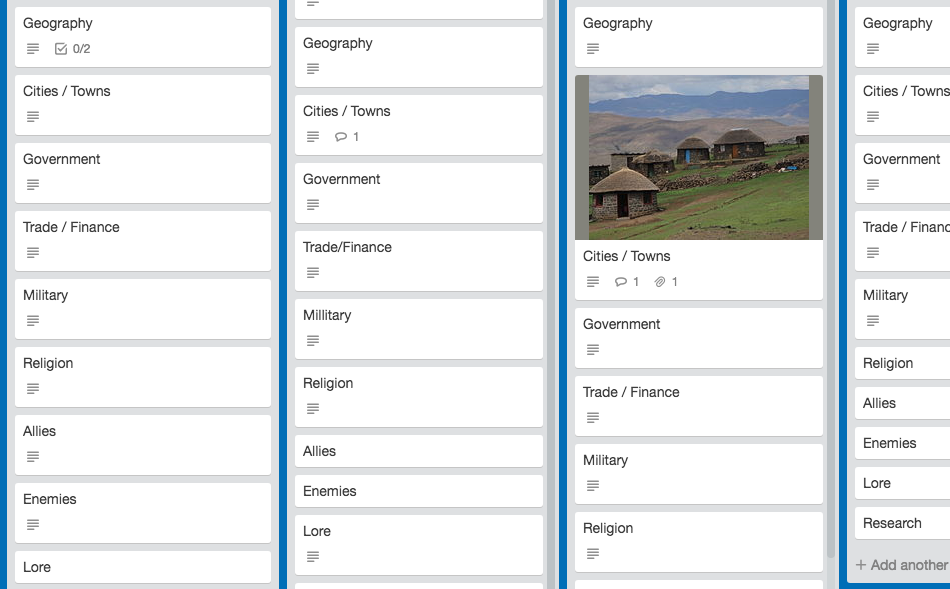World building is important to any fiction novel. In it’s simplest it is just setting up the geographical space that the characters and the story operate in.
For a Fantasy novel where the entire world is a fictional construct it is a much bigger job than it can be in more real life settings. I knew this before I started on the novel and I think the magical, wonderful and diverse worlds of some of the best Epic Fantasy novels I’ve read are a big part of the attraction.
It doesn’t have to be as elaborate as Tolkien’s worlds with languages and history dating back thousands of years, but the richness of the world is part of what makes the story so powerful.
The types of races, their unique characteristics, the geography and architecture all are an open slate to build on.
Which of course is as much a curse as it is exciting.
Where do you start?
How far do you go?
As a first time Fantasy author I could see a bunch of pitfalls in the process of world building. It’s so much easier to research and create worlds than lay down tens of thousands of words in your draft.
What comes first, the chicken or the egg?
For me it was a bit of both. I had to have a world and so I started there. I found an amazing resource ‘A Magical Society: Guide to Mapping’, www.exp.citymax.com, which covers a load of information about making a map that makes sense.
I used this to shape my world and give it the depth and texture it needed with enough earth like realities to make it feel suitable for me. In this series I felt I had enough to do to make the story work and bring out the characters that I didn’t want the additional challenge of a completely different set of worlds that would require much more from me than I might be able to give.
The basics of the geography worked well to give the world some structure, something tangible I could look at and build out from.Then came the detail.
I worked my way through creating the key realms that matched to the landmasses and suddenly it dawned on me how much more was required.
The detail that is needed to give substance to the countries, populations, religions, economies becomes mind boggling. Much as I do day to day I turned to my favourite online organisation tool, Trello, to help me capture and store the information as I created it.
As you can see in the image below, I created lists for each of the realms, sorry no spoilers here I’ve not displayed the tops of each column, and added in the same cards in each one.

Progressively as I finalised the back-story and history to the world and those events that came before when my story started I was able to start filling in the tiles (cards) in trello and not lose my way.
As I created the races and search for visual imagery and words that reflected what I wanted I ended up in an ever-cascading world of research, none of which was actually helping me write anything that would go into my manuscript.
At that point I had a decision to make, which ended up being me choosing to scratch the itch and start the book. And I am so glad I did. The first scenes began flowing out of me and before long I had twenty thousand words on paper (well in my writing app).
Then I hit a hurdle. My main character needed to leave their surroundings and while I knew the immediate surroundings I started having to write they left XXXX and headed to XXXX (well not quite like that), and that became very problematic.
This was my first big pause in my writing, as I then had to go back and finish what I had started. It’s not just about the names of the towns or cities but in being able to adequately describe where the characters are you need to be able to give names and descriptions to rivers or woodlands and mountains.
It took me at least another three months of plotting out all the cities, towns and roads that mattered in my main landmass, and then filling in the elements around it that allowed me to progress.
It worked for me, and the next one hundred and sixty thousand words came out and the world took shape before my eyes.
I am not sure I could have done it much differently; the story directed parts of what the world needed to be and the world has obviously shaped the story.
There’s been a lot more world building happen in the later stages of the editing and revisiting how everything works together, and the beauty of Book 1, A Fool’s Errand, is that it only touches on certain parts of the map and world so there is much more to expand and reveal throughout the series.
Of course there is a map, I have had one carefully created by a wonderful artist and that will be part of our reveals once the book readies for market.
You can see it before others by joining my list.













